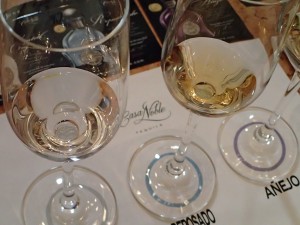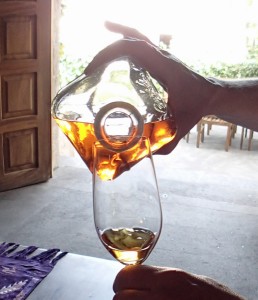“Tequila makes me crazy, so I kinda steer clear of it,” said the woman mixing a batch of paint for me at a shop last weekend. She said that with a roll of her eyes and a grin, implying some past misbehavior born of excess tequila consumption.
“That didn’t have anything to do with the amount you drank, did it?” I asked. Again, she grinned sheepishly.
“And it probably wasn’t any good to begin with. I don’t know a thing about tequila,” she said.
Most don’t. Or at least good tequila. Me included until a few years ago, and even then, I only understood it as the backbone of a really good margarita.
As has become the norm with me, I learn the most about any spirit by sipping it straight, sniffing it a lot and sipping it some more. I also like to read about it and consult knowledgable sources (and we have no shortage of them in this town, which is a blessing!) Slowly, over time, 1 ounce in 30 minutes, give or take 10 minutes, in a chair, Kindle in hand. That’s one way you get to know good tequila and its flavors, nuances, colors and aromas. Never by doing shots with salt, lime or lemon.
What moron came up with that combo anyway?
Easy: The marketing genius who convinced people to squeeze citrus into bad beer.
So my first tequila epiphany occurred 12 years ago when a server at Mama Rosa’s—remember that Peruvian restaurant on Breckenridge Lane?—talked me in to having a true top-shelf margarita made from Don Julio Silver. It was terrific, bore some bite with flavors of fruit and white pepper. I almost never had cheap margaritas afterward.
The second and most important lesson spurring my love affair with the spirit came two years ago when Casa Noble master distiller Jose “Pepe” Hermosillo hosted a tequila dinner at The Blind Pig. Nearly every taste was straight, just an ounce or so of “the juice,” as fans call the product of steamed and fermented agave pulp. It was fantastic, loaded with notes of cinnamon, vanilla and citrus, characteristics shared with bourbon, since both are barrel aged.
I was hooked.
Well, as hooked as one can get on $40 a bottle—and WAY MORE—booze.
What deepened my appreciation for it was being invited with a group of food, beverage and lifestyles writers to Casa Noble’s distillery in Tequila, Mexico last winter. When the owner breaks out the good stuff for private tastings, the experience is difficult to convey with written words.
The good thing about the high price of great tequila is it forces you to savor it over time. It’s not for every night sipping at Chez Coomes. Sure, it’ll work in cocktails, but pouring great reposado or anejo (1 to 3 year old tequilas) into a margarita is a bit like putting on a tuxedo to fetch the mail. It’s unnecessary overkill for a drink that’s as much about the flavors of its other components as it is tequila.
So, since it’s National Tequila Month, I thought I’d share a helpful hints I’ve picked up over the past two years of committed study to understanding what has unseated gin as my favorite spirit.
1. Only buy tequila made from 100 percent blue agave, the plant from which it’s made. There are bargain priced versions of this, so at the very least, start there. It’s also wise to buy tequila made only in Jalisco, the Mexican state that’s home to the town of Tequila.
2. There are three basic grades of tequila: silver, reposado and anejo.
Silver (also called blanco, plata, crystal, white and platinum) is generally un-aged, though some brands, such as Herradura, give it a month or so in the barrel for just a little more flavor. Its flavor is bright, fruity and peppery, which make it perfect for cutting through cocktail additives. If you like straight spirits that deliver a bite along with that flavor—and I do—silver does the trick. It’s also less expensive, in most cases, than its older styles.
* A sort of sub-category of silver that has developed is worth noting: Joven, which is still-strength, i.e. white lightning, only a tequila version. I tried some at Casa Noble and it was fantastic, but at 126 proof it’s hot and delivers a memorable kick.
Reposado is tequila aged two to 11 months in wood barrels that 99 percent of the time are spent bourbon barrels from Kentucky. (Casa Noble, it should be noted, is the only distiller using new French white oak barrels that are lightly toasted, and Don Julio uses some new American white oak barrels for its high-end “1942”.) The bite of silver is softened considerably with some age, and the flavors of the barrel—cinnamon, orange, caramel, etc.—move to the front. Due to age-induced evaporation, reposado also has more body than silver as well, so its mouthfeel is softer.
Anejo is tequila aged longer than 11 months, though the great ones are aged at least two years. Those stretching to three to five years are called extra anjeo, but such varieties are both hard to find and pricey and fetch $100 and more. All the flavors and textures of reposado are amplified markedly in anejo: highly complex barrel notes, weighty body and truly silky softness. Great anejo is savored, sipped and sniffed slowly.
Anjeo also must be aged in barrels smaller than 600 liters—which is a huge barrel; a bourbon barrel is about 300 liters—to increase those flavor concentrations.
While at Casa Noble, Hermosillo gave us tastes of his “experiments”: a 5-year-old extra anejo held in a 300-liter barrel, and a 5-year old extra anejo from a 100-liter barrel. I’ve never tasted any spirit so good in my life as the 100-liter version. It was worth the harried three-day up-and-back trip to taste just that. (If it ever makes it to market, surely its price would be at least a few hundred dollars.) See the picture above and notice the body of it in the glass.
Some recommendations on brands:
- Anything Casa Noble. I haven’t tasted every tequila, but I’ve sampled many kinds. I have yet to find better anjeo. Its silver is bright, aromatic and fun, and worth the nickel.
- Don Eduardo reposado is a great middle-ager. Floral, warm, inviting, loads o’ cinnamon.
- Avion makes a terrific anejo that’s got a much lighter body than, say, Casa Noble, but that lack of structure seems to allow some nuances to emerge on the palate. A great spirit all around.
- Anything Milagro. No better bargain on the market, especially the silver, which costs $23 for a 750ml. Its reposado has great edges that make for some spicy sipping.
- Don Julio Blanco brings tons of citrus to the glass, which means it’s a great mixing tequila. (I was treated recently to a taste of the Don Julio 1942, which is aged in American white oak, and I wasn’t wowed by it, especially for the $125 per bottle price. Still, to each his own. Someone else may love it.)
- Herradura tequilas are about as reliable as you get. Nothing fancy, but no flaws. You’ll never go wrong here.
- Gran Centenario any age. Very pure, elegant and a great standard to go by. But super pricey. Hide it from your friends.
So what about Patron or Cabo Wabo (Sammy Hagar’s brand), two very popular tequilas? Both are fine, steady drinkers, but both are cocktail tequilas. Both lack depth and complexity; neither is a great sipping tequila. Patron, frankly, is way overpriced, not a value at all, so I don’t buy it, but will drink it if offered.
** PS: You know how every alcoholic beverage advertisement says to “drink responsibly”? Great wisdom worth practicing.



Leave a Reply